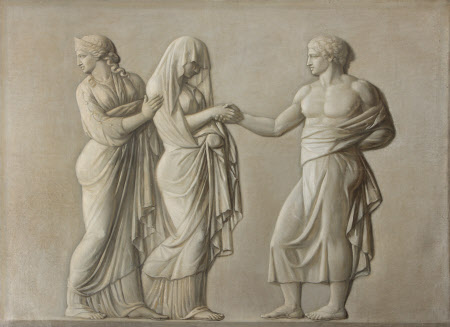The Marriage of Peleus and Thetis
Robert Fagan (1761 - Rome 1816)
Category
Art / Oil paintings
Date
1793 - 1795
Materials
Oil on canvas
Measurements
1117 x 1486 mm (44 x 58 1/2 in)
Place of origin
Italy
Order this imageCollection
Attingham Park, Shropshire
NT 609083
Caption
Robert Fagan was a somewhat bohemian figure of Irish parentage who lived in Rome from 1784 to 1807, painting portraits, excavating and selling classical sculpture, and dealing in Old Masters. He was Consul General at Naples and Palermo. In 1799 in association with another artist, Charles Grignion (1754-1804), he acquired the two famous Altieri paintings by Claude (1600-1682) and under difficulties shipped them to England where they were bought by William Thomas Beckford (1760-1844). In a fit of melancholia in 1816 he committed suicide by throwing himself out of a window. All four grisailles (monochrome paintings) by him at Attingham were presumably commissioned by Thomas Noel Hill, 2nd Lord Berwick (1770-1832), on his visit to Italy in July 1792. They were all copied from antique prototypes, this one after a terracotta relief in the Campana Collection , now in the Louvre, Paris. It shows Peleus, a hero of Ancient Greece, and Thetis, a sea nymph, who were the parents of Achilles.
Summary
An oil painting on canvas depicting the Marriage of Peleus and Thetis. The Classical hero Peleus married the sea-nymph Thetis and their wedding feast was attended by many of the Olympian gods. Achilles was the son born to Peleus and Thetis. The paiting is by Robert Fagan (Cork c.1745 – Rome 1816) and was done around 1793 to 1795. Fagan lived in Rome from 1784 to 1807, painting portraits, excavating (notably the Capitoline Venus type at Campo Iemini, near Torvaianica, Lazio in the British Museum), selling clsssical sculpture and dealing in Old Masters. The painting is a grisaille overdoor for the Entrance Hall at Attingham Park and was comissioned by Thomas, 2nd Lord Berwick (1770-1832). The painting is derived from Nova Nupta, in Pietro Santo Bartoli's 'Admiranda Romanarum Antiquitatum' (1693), fig. 57, from the relief 'In Aedibus Farnesianis'; after a terracotta relief in the Campana Collection in the Louvre, Paris. The paintings depicts three full-length figures. On the left a female figure, turned to the right, is shown with her head in profile to the left. Her left foot points forward and her right hand rests on the shoulder of the female figure in the centre. The female on the left is wearing classical robes and has a diadem in her hair with ringlets falling to her shoulders. The central female figure is turned to the right. She has her head bowed and is holding her classical robes up at the waist with her left hand. Her head is covered by a veil and her right hand holds the hand of the third figure, a male. The male figure on the right is turned to the left. He is in profile, bare-chested and bare-footed with classical robes, and has short tightly-curled hair. He is holding the central female figure’s hand with his right hand and his left hand is held behind his back.
Provenance
Presumably commissioned by Thomas Noel Hill, 2nd Lord Berwick (1770-1832) on his visit to Naples in 1792/3; bequeathed to the National Trust in 1947 with the estate, house and contents of Attingham by Thomas Henry Noel-Hill, 8th Baron Berwick (1877-1947) on 15th May 1953.
Credit line
Attingham Park, The Berwick Collection (National Trust)
Makers and roles
Robert Fagan (1761 - Rome 1816), artist

